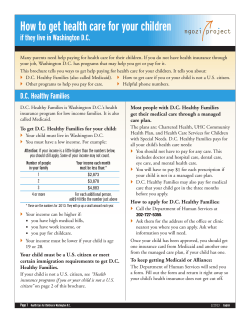
MMIS and Behavioral Health Data Interoperability: Why Care?
MMIS and Behavioral Health Data Interoperability: Why Care? Jeffrey A. Buck, Ph.D. jeff.buck@samhsa.hhs.gov Incentives for Medicaid – MH Data Interoperability General Survey Analysis and Financing Branch trends in state MH financing Recent changes in Medicaid policy Health care reform Health IT initiatives General Trends in State MH Financing Survey Analysis and Financing Branch State MH Organization & Financing Survey Analysis and Financing Branch State-based MH service systems are transitioning from a model based on grant/ contract financing, and provider needs to a “Medicaid-centric” one in which health plan financing models predominate and MH providers are mainstreamed into the larger health care system. Financing Trends Survey Analysis and Financing Branch Medicaid is growing faster than other sources of public MH spending MH Public Payer Shares, 1993-2003 Survey Analysis and Financing Branch Survey Analysis and Financing Branch “The increasing reliance on Medicaid to fund mental health services has made the Centers for Medicare and Medicaid Services the de facto federal mental health authority.” Campaign for Mental Health Reform July, 2005 Medicaid Expenditures for MH/SA Service Users Survey Analysis and Financing Branch Medicaid Inpatient Days Survey Analysis and Financing Branch Comorbidity of Medicaid MH Users MH Survey Analysis and Financing Branch service users make up a major portion of high cost Medicaid enrollees Jones et al. (2004) - 74% of SMI in Medicaid had at least one chronic health problem; 50% had two or more Another Medicaid study found that of different pairings of chronic co-morbid conditions, psychosis was a factor in 5 of the 7 highest cost pairs Costly Physical Conditions – 22-64 Survey Analysis and Financing Branch Medicaid and State MH Agencies MH Survey Analysis and Financing Branch agencies administer the public MH safety net and set data and reporting standards for specialty MH providers These agencies increasingly administer part of the Medicaid program: In 22 states more than half of state MH agency community spending is from Medicaid Important sectors of the service system fall outside SMHA overview – e.g., primary care physicians, nursing homes, and ERs Recent Changes in Medicaid Policy Survey Analysis and Financing Branch Reinforce State Medicaid Authority Survey Analysis and Financing Branch “The [Medicaid] agency must not delegate . . authority to exercise administrative discretion in the administration or supervision of the plan, or issue policies, rules, and regulations on program matters.” “If other State or local agencies or offices perform services for the Medicaid agency, they must not have the authority to change or disapprove any administrative decision of that agency, or otherwise substitute their judgment for that of the Medicaid agency . . .” Increase provider accountability Audit Survey Analysis and Financing Branch disallowances – poor documentation Increased requirements for planning & provider qualifications Increased audit activity Incentives for state false claims acts Medicaid Integrity Program ($75 mil for 09 and beyond) & more $ for Inspector General Provider compliance program rqrmnts Promote comm-based services Clarification Survey Analysis and Financing Branch of availability of HCBS waivers (1915c) for adults w/MI (new – WI and MT) New Section 1915i (DRA) States can offer HCBS as a state plan optional benefit (e.g., respite, habilitation, partial hosp) Doesn’t require “cost neutrality,” imminent institutionalization, or hosp/NF linkage Can focus on MI (IA, plus GA & NV proposals) Individualized, person-centered care plans Health Care Reform – Medicaid and MH Expand Survey Analysis and Financing Branch eligibility based on income, including SCHIP children and childless adults Increase Medicaid primary care payment rates Reduce disproportionate share payments Also – Effects of downturn Survey Analysis and Financing Branch Michigan Gov. Jennifer Granholm (D) "has proposed shaving $40 million from non-Medicaid community mental health programs...in the new fiscal year, continuing cuts she imposed by executive order in May." Meanwhile, "the state Senate passed a 2009-10 budget that would cut $61.8 million from non-Medicaid mental-health services." Detroit News 8/11/09 Health IT Survey Analysis and Financing Branch Need for interoperable systems President's Survey Analysis and Financing Branch New Freedom Commission on Mental Health harness the power of health information technology and leverage resources through better federal, state, and local collaborations Institute MH/SA of Medicine quality report services lag behind general health care in the use of information technology Recommends policies/infrastructure to create linkages among MH/SA patient records and related data, and standardization of different reporting/billing requirements MITA Survey Analysis and Financing Branch “The MITA initiative envisions moving from traditional MMIS to webbased,patientcentric systems that are interoperable within and across all levels of government.” Source: NASCIO ONC Vision Implementation Survey Analysis and Financing Branch of IT to allow information to flow freely between patients, providers and payers. By 2015, have 90% of providers and 70% of hospitals with EHRs with “meaningful use” of health information. Status Quo: MH and Medicaid data incompatibility Survey Analysis and Financing Branch SMHA and Medicaid data are limited in their compatibility - differences in data elements and coding mean that identical service events cannot be identified with confidence Many states maintain multiple MH IT platforms & about half use “legacy” systems Nearly half use unique service coding system and DSM IV for dx codes Less than half have detailed prescription drug data MH Specialty Providers Approximately Survey Analysis and Financing Branch 2000 organizations serve nearly 3 million persons annually Number one funder is Medicaid Only about a third of these providers have some form of EHR, which may or may not meet federal certification standards Generally not eligible for Recovery Act IT funding Conclusions Financing Survey Analysis and Financing Branch trends, Medicaid policy changes, and health care reform all point to greater integration of states’ MH systems into Medicaid Although a critical part of the public health safety net, MH agencies and providers are very far from meeting expectations for having EHR-based, interoperable data systems that meet federal standards Conclusions Current Survey Analysis and Financing Branch federal initiatives are unlikely to address state-level IT issues with Medicaid MH providers The extensive dependence and interaction of this system with the Medicaid program means that attention is needed to how it will be brought into equivalence with other classes of Medicaid providers Conclusions Failure Survey Analysis and Financing Branch to create genuinely interoperable systems will likely lead to: Increased audit vulnerability Failure to capture legitimate FFP Provider burden System duplication and inefficiencies Failure to realize health IT vision Conclusions Survey Analysis and Financing Branch MITA offers a solution! Survey Analysis and Financing Branch
© Copyright 2025









